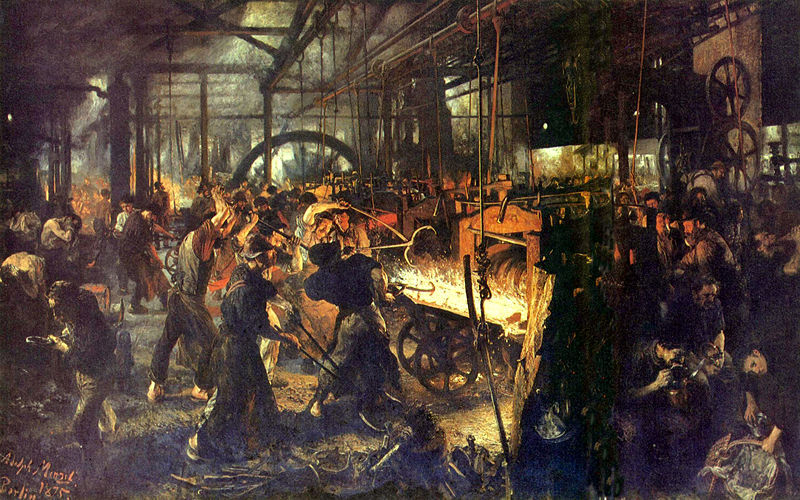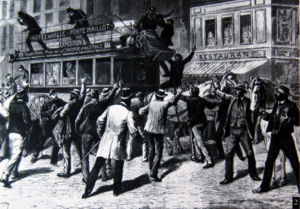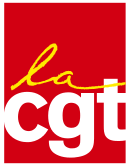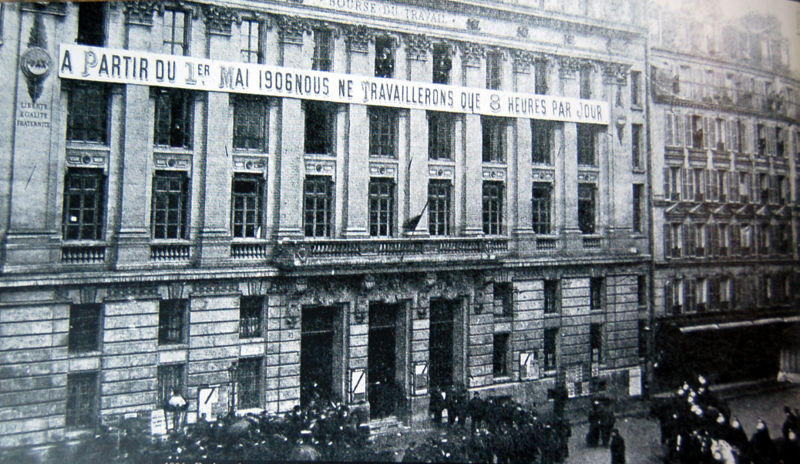Trade unions were officially recognized in France in 1884. Initially, the Church was mainly on the side of the upper bourgeoisie. However, a number of Catholic thinkers were also aware of the working conditions faced by workers. This is why many trade unions were linked to religion. In France, a large number of Christian trade unions came to life. From then on, workers managed to improve their fate and working conditions: health and safety legislation, weekly rest, retirement, etc.
As with the emergence of social and fair trade ideologies, the miserable conditions of workers stimulated the creation of trade union movements. After the French Revolution, economic liberalism prevented workers from organizing and defending their interests. In the early 19th century, workers did not have the right to form trade unions. To obtain this right, workers had to demonstrate and revolt, as they did during the Paris Commune. Workers' movements were born during the Industrial Revolution, when working conditions were harsh and there were no laws to regulate the work demanded by employers.

The workers were strongly influenced by the theories of Marx and Engels and socialist criticism. The workers began a real battle against bourgeois employers and the state, which tried to suppress workers' revolts.
This vision of trade unionism as a social struggle between two distinct groups has marked the entire history and philosophy of trade unionism. The links between workers' demands and politics were very strong at the time, and were associated with the class struggle described by Marx. The first workers' associations aimed to bring about major social and worker transformation, leading to the dictatorship of the proletariat. In France, for example, workers' revolts were directly linked to the social and political turmoil that followed the French Revolution.

It should be pointed out that workers‘ rights were non-existent at the time, and workers’ associations were even banned by law. The only means available to workers were revolts, riots and violent strikes. Workers had to impose their demands by force. What's more, in the absence of government social programmes, the unions had to fight for social protection: family care, sickness, pensions, education, accidents at work, etc.
The socialist critique of Marx and Engels initiated a trade union battle marked by class struggle. In this socialist vision, trade unions were directly linked to political parties and depended on them. Several trade unions in France, Germany and England were founded with these objectives in mind. Later, the unions drew distinctions between socialist objectives and communist aims.
On the other hand, many unions were born with more anarchist aims. Anarcho-syndicalism not only wanted to put an end to capitalism, but also rejected the dictatorship of the proletariat. In fact, anarchists wanted to fight for the total freedom of individuals. These two theoretical axes provided the knowledge and the means of action for the trade unions, which encouraged their growth from 1880 onwards.
In 1791, a law came into force prohibiting any form of association in the world of work. At the start of the Industrial Revolution, workers had to submit to existing working conditions, with no means of improving them. A few fraternal benefit societies gradually sprang up, and workers began to use pressure tactics such as strikes, machine break-downs and demonstrations. However, police repression always put the brakes on these movements.
Over the years, the movements became divided into two trends: groups making claims and groups seeking to manage social needs. At the same time, the right to strike was granted and trade unions were tolerated. It was not until 1884 that trade unions were officially legalised. However, tensions still divided the different groups of workers. Some wanted unions that were directly linked to political parties (the influence of Marxism), while others wanted unions that were dissociated from political parties.
Negotiations between these two branches led to an agreement, creating the General Confederation of Labour (GCT). This confederation, inspired by anarchist and revolutionary theories, really gave rise to the great trade union struggles of the 20th century in France, influenced by the Russian revolution. After the First World War, the unions developed a new mindset: negotiation with the State. Several major strikes left their mark on France, including the railway workers' general strike in 1920.

The trade union world, still divided between the Socialists and the Communists, saw the emergence of new movements, such as the Christian trade unions. The tide turned radically for the unions in 1936 with the election of the left-wing Popular Front party. The working class realised the strength it could bring to bear: several general strike movements affected the whole of France. The 1936 agreement led to an improvement in working conditions for workers, with the recognition of a number of labour rights and laws: the start of the 40-hour week, the introduction of paid holidays, collective agreements, and so on. During negotiations, the State did not organise repression, but played the role of mediator between workers and employers. These major innovations marked the beginning of mass trade unionism in France.
Here is a list of some of the trade union achievements in France since 1884:
- 1884: Law authorizing the creation of trade unions;
- 1892: Ban on night work for women;
- 1906: Compulsory 24-hour rest per week;
- 1910: Law on peasant and worker retirement;
- 1919: Law limiting the working day to 8 hours and the working week to 48 hours;
- 1930: Start of social insurance;
- 1932: Start of family allowance;
- 1936: General pay rise, 40-hour week, paid holiday for 2 weeks a year, recognised collective agreement;
- 1945-1947: Creation of works councils, social security, pay scale, right to strike enshrined in the constitution;
- 1950: Law for a guaranteed minimum wage;
- 1956: 3 weeks paid holiday per year, solidarity fund for older workers;
- 1968: 4 weeks paid holiday per year;
- 1971: Monthly wage payments;
- 1974: Access to 90% unemployment benefit in the event of redundancy;
- 1982: 39-hour week, 5 weeks paid holiday per year, retirement at 60;
- 2000: 35-hour week;
- 2008: Plan to abolish the 35-hour week to allow overtime.
A trade union is an association dedicated to defending the rights and interests of employees in their relations with their employer.
Remember that trade unions are associations of people united by common objectives, both professional and economic. The union's task is to defend its members in their dealings with company leaders and employers. Demands may relate to wages, working conditions, insurance, holiday pay, working hours, etc. Unions differ in their nature (trade association, group linked to a single employer, central labour body) and in the way they operate. While some unions focus on collaboration between their members and employers, other union groups are more influenced by revolutionary or anarchic ambitions.
Employers and employees are bound by a contract: the collective agreement. The collective agreement sets out the working relationship and the employer's commitments in terms of holiday pay, wages, seniority rules, tenure and social benefits.
The collective agreement also defines the working framework for employees: working hours, tasks to be carried out. The collective agreement has a limited duration, so that it can be amended regularly (between 2 and 4 years on average).
In all cases and for all demands, trade unions have the same means of action: negotiation, strike action and protests. Negotiations are the first step that unions must take with employers. The two parties then try to reach agreements and compromises between the demands of the workers and those of the employers. When negotiations fail, employees may go on strike. They then cease all activity to put pressure on their bosses. During a strike, workers often organize protests to make their demands known to the public. Public protests are often used to denounce an employer's abuses and therefore sway public opinion in favour of the employees.

However, public opinion can also be negative if the strike and protest damage the functioning of society, as in the case of a doctors' strike or a transport strike. Employers have often used new employees, known as strikebreakers, to carry out the tasks abandoned by the strikers. However, in several countries, such as Canada, employers are prohibited from using strikebreakers. This ban has been imposed to prevent employee strikes from being ineffective. When negotiations stall, employers may themselves decide to close the business. The lock-out then allows the bosses to put pressure on their employees.
There are also international trade union confederations, such as the International Trade Union Confederation (ITUC), which aim to achieve a general improvement in working and living conditions for workers and their families. These associations also strive for respect for human and trade union rights. Today's trade union struggles are markedly different between rich and developing countries. It is for this reason that international trade unions serve as a link between the achievements of workers in more developed countries and the demands of workers in developing countries.